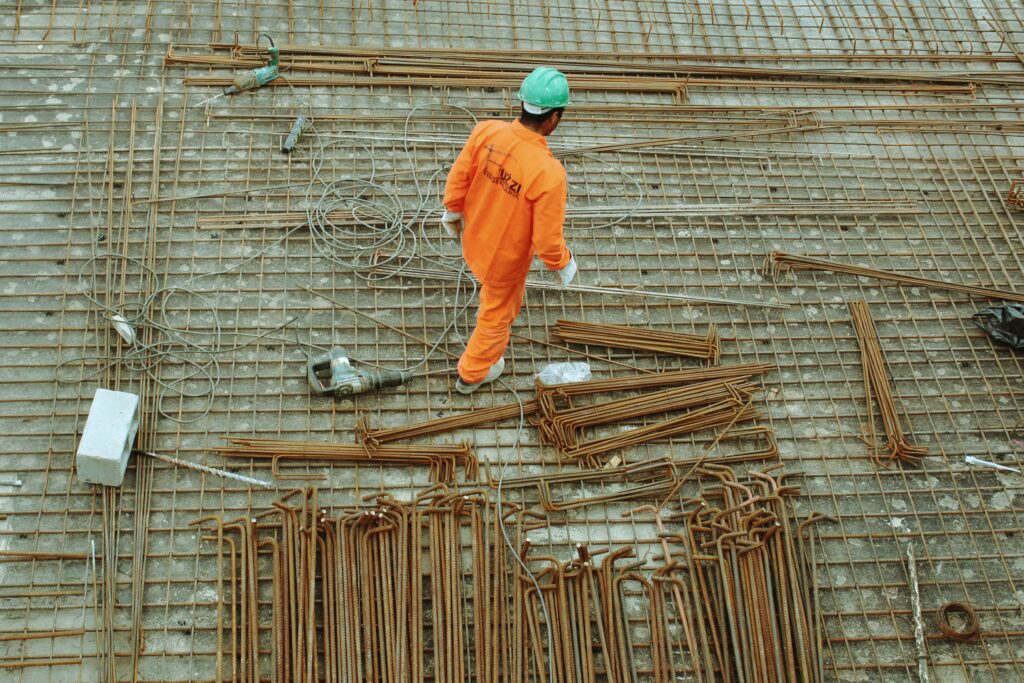You are about to embark on a journey of discovering the latest advancements in construction techniques for shopping centers. From state-of-the-art materials and innovative design concepts to sustainable practices and enhanced efficiency, this article will provide a comprehensive overview of the ground-breaking innovations shaping the future of shopping center construction. Get ready to be amazed by the game-changing advancements that are revolutionizing the way these commercial hubs are built.



This image is property of images.unsplash.com.
Adopting Digital Technologies in Construction
Use of Building Information Modeling (BIM)
One of the most significant innovations in the construction industry is the use of Building Information Modeling (BIM). BIM is a digital representation of a building’s physical and functional characteristics. It allows architects, engineers, and construction professionals to collaborate more efficiently by creating a central database of information. With BIM, all project stakeholders can access accurate and real-time data, resulting in improved decision-making and reduced errors. This technology enables a more streamlined construction process, minimizing project delays and maximizing productivity.
Adoption of 3D printing
Another digital technology revolutionizing the construction industry is 3D printing. This innovative technique involves using computer-controlled machines to create three-dimensional objects layer by layer. In construction, 3D printing allows for the fabrication of complex structures with intricate designs and high precision. This technology allows for faster construction time, reduced costs, and increased customization options. It has the potential to revolutionize the industry by enabling the construction of unique and sustainable buildings.
Integration of Artificial Intelligence and Machine Learning
Artificial Intelligence (AI) and Machine Learning (ML) are being integrated into construction processes, transforming the way projects are planned, executed, and managed. AI and ML algorithms can analyze large amounts of data to identify patterns, make predictions, and optimize construction processes. This technology can automatically generate construction schedules, detect potential risks, and improve safety monitoring. By harnessing the power of AI and ML, construction companies can enhance their decision-making, increase productivity, and achieve better project outcomes.
Location Tracking Technologies
Location tracking technologies, such as Global Positioning Systems (GPS) and Radio-Frequency Identification (RFID), are becoming increasingly prevalent in the construction industry. These technologies provide real-time data on the location of construction equipment, materials, and workers, allowing for efficient project management and resource allocation. With location tracking, project managers can monitor progress, track the movement of materials, and ensure that construction activities are on schedule. This technology improves project coordination, reduces theft, and enhances overall construction site safety.
Modular and Prefabricated Construction
Efficiency and Speed of Modular Construction
Modular construction involves the fabrication of building modules off-site in a controlled environment, which are then transported to the construction site for assembly. This construction method offers numerous advantages, including increased efficiency and speed. Modular construction allows for simultaneous on-site and off-site work, resulting in reduced construction time. The controlled environment ensures high-quality manufacturing, minimizing errors and rework. By adopting modular construction techniques, shopping centers can be built faster and more efficiently, enabling businesses to start operating and generating revenue sooner.
Sustainability Benefits
Modular construction is also a sustainable construction technique. By manufacturing building modules in a controlled environment, waste can be minimized, and materials can be used more efficiently. The off-site fabrication process enables better management and recycling of construction waste. Additionally, modular construction can incorporate sustainable materials and building practices, such as energy-efficient insulation and renewable energy systems. By adopting modular techniques, shopping centers can contribute to a greener and more environmentally friendly future.
Options for Design Flexibility
Modular construction offers a wide range of design flexibility, allowing for customized and unique shopping center structures. Building modules can be assembled and arranged in various configurations, accommodating different floor plans and spaces. This flexibility allows for the creation of attractive and engaging shopping environments that cater to specific customer needs. Modular construction also allows for future expansions and modifications, making it a cost-effective and adaptable solution for shopping center developers.



This image is property of images.unsplash.com.
Innovations in Construction Materials
Smart Concrete and Bricks
Advancements in construction materials have led to the development of smart concrete and bricks. Smart concrete is enhanced with embedded sensors and microchips, allowing it to monitor its own structural integrity, detect cracks, and report damage. This technology enables early identification of potential issues, preventing costly repairs and ensuring the longevity of shopping center structures. Smart bricks, on the other hand, can incorporate solar panels or energy storage devices, contributing to energy efficiency and sustainable design. By utilizing these innovative materials, shopping centers can enhance durability, efficiency, and sustainability.
Use of Recycled Materials
The construction industry is increasingly focusing on incorporating recycled materials into building projects. By using recycled materials, shopping centers can reduce their environmental impact and contribute to a circular economy. Recycled materials, such as recycled concrete aggregates and reclaimed wood, can be used in various construction applications, including foundations, walls, and flooring. These materials not only reduce waste and conserve natural resources but also offer comparable performance to traditional construction materials. The use of recycled materials in shopping center construction demonstrates a commitment to sustainability and responsible resource management.
Advanced Insulating Materials
Insulation plays a crucial role in energy efficiency and thermal comfort in buildings. Innovations in insulating materials have led to the development of advanced solutions that enhance the performance of shopping center structures. These materials, such as high-performance insulation foams and vacuum insulation panels, offer superior thermal insulation properties, reducing heating and cooling energy consumption. They also contribute to noise reduction and improved indoor air quality. By adopting advanced insulating materials, shopping centers can create a comfortable and energy-efficient environment for customers and employees.
Green Building Techniques
Energy Efficient Design
Energy-efficient design techniques are essential for creating sustainable shopping centers. Strategies such as proper building orientation, efficient lighting systems, and optimized HVAC systems can significantly reduce energy consumption. By incorporating energy-efficient design principles into shopping center construction, developers can minimize the environmental impact, reduce operating costs, and create a comfortable shopping experience for customers.
Solar Power Integration
Solar power integration is a popular green building technique that harnesses the energy of the sun to power shopping center operations. By installing solar panels on the roof or using solar canopies in parking areas, shopping centers can generate clean and renewable energy. Solar power integration not only reduces reliance on grid electricity but also provides an opportunity for cost savings through reduced energy bills. By embracing solar power, shopping centers can showcase their commitment to sustainability and have a positive impact on the environment.
Water Conservation Techniques
Water conservation is another important aspect of green building techniques for shopping centers. Innovations such as rainwater harvesting systems, low-flow fixtures, and efficient irrigation systems can significantly reduce water consumption. By implementing water conservation techniques, shopping centers can conserve natural resources, reduce water bills, and contribute to the overall sustainability of the community. Customers are increasingly attracted to environmentally conscious businesses, and the adoption of water conservation techniques demonstrates an organization’s commitment to responsible water usage.



This image is property of images.unsplash.com.
Automation in Construction
Use of Drones for Surveying
Drones are increasingly being utilized in construction projects, including shopping center developments. Drones equipped with high-resolution cameras and LiDAR technology can capture aerial images and collect accurate data about the construction site. This information can be used for surveying, monitoring progress, and creating 3D models. The use of drones for surveying eliminates the need for manual measurements and reduces the time required for site inspections. This automation technology improves surveying efficiency, enables more frequent progress updates, and enhances overall construction project management.
Robotics for Hazardous Tasks
Robotic technology is making hazardous construction tasks safer and more efficient. Robots can be used for tasks such as heavy lifting, concrete pouring, and demolition, reducing the risk of injuries to human workers. These machines are capable of performing repetitive tasks with precision and speed, improving productivity and reducing construction time. By adopting robotics for hazardous tasks, shopping center construction sites can prioritize worker safety and optimize construction processes.
Automated Design and Planning Tools
Automated design and planning tools, such as computer-aided design (CAD) software, are widely utilized in the construction industry. These tools enable architects and engineers to create realistic 3D models, simulate construction processes, and optimize building designs. By leveraging automated design and planning tools, shopping center developers can visualize the project before construction begins, identify potential issues, and make necessary modifications. This technology streamlines the design and planning phase, minimizing errors and ensuring the efficient use of resources.
Safety Innovations
Wearable Tech for Workers
Wearable technology is revolutionizing safety in the construction industry. Devices such as smart helmets, safety vests with built-in sensors, and biometric monitors can monitor workers’ vital signs, detect falls or accidents, and provide real-time alerts. Wearable tech enhances onsite safety by enabling immediate response in case of emergencies and improving overall situational awareness. By adopting wearable tech for workers, shopping center construction sites can prioritize worker safety, reduce accidents, and create a safer working environment.
Enhanced fire safety systems
Fire safety is a critical consideration for any construction project, particularly in shopping centers where large numbers of people gather. Enhanced fire safety systems, including advanced fire detection sensors, sprinkler systems, and automated fire suppression technologies, can detect and respond quickly to fire incidents. These systems minimize the risk of property damage and, more importantly, protect the lives of customers, employees, and emergency responders. By integrating enhanced fire safety systems, shopping centers can provide a safe environment for all occupants.
Advanced Medical Emergency Response System
An advanced medical emergency response system is essential for ensuring the well-being of construction workers and shoppers in the event of an emergency. This system can include features such as emergency medical kits, automated external defibrillators (AEDs), and real-time communication devices. By having an advanced medical emergency response system in place, shopping centers can quickly respond to medical emergencies, provide immediate care, and potentially save lives. Prioritizing the safety and well-being of customers and employees enhances the overall shopping center experience.



This image is property of images.unsplash.com.
Construction Project Management Innovations
Cloud-Based Project Management Software
Cloud-based project management software has revolutionized the construction industry by enabling real-time collaboration, document sharing, and project tracking. Construction project teams can access project information from any location, facilitating communication and reducing the risk of miscommunication. Cloud-based software allows for seamless integration with other project management tools and provides a centralized platform for project documentation, schedules, and budgeting. By adopting cloud-based project management software, shopping center developers can streamline project workflows, improve communication, and ensure efficient project delivery.
Augmented Reality for On-Site Evaluation
Augmented Reality (AR) has emerged as a powerful tool for on-site evaluation and visualization of construction projects. By overlaying virtual elements onto the real-world environment, AR allows for a more immersive and interactive experience. Architects, engineers, and contractors can use AR to view 3D models, assess design elements, and identify potential clashes or discrepancies. With AR, on-site evaluation becomes more efficient, reducing the need for physical mock-ups and enabling better decision-making. By embracing AR technology, shopping center developers can enhance the accuracy of on-site evaluations and improve overall project outcomes.
Enhanced Communication Tools
Effective communication is crucial for successful construction projects, and advancements in communication tools have greatly improved project coordination. Integrated communication platforms, virtual meeting tools, and mobile applications enable seamless collaboration and information exchange among project team members. By utilizing enhanced communication tools, shopping center developers can ensure that all stakeholders are aligned, and project timelines and milestones are met. Improved communication leads to reduced misunderstandings, increased efficiency, and ultimately, a successful shopping center construction project.
Energy-Efficient Lighting Solutions
LED Lighting
LED lighting has become the standard for energy-efficient lighting solutions in shopping centers. LED lights consume significantly less energy than traditional lighting sources, resulting in lower energy bills. They also have a longer lifespan, reducing maintenance and replacement costs. LED lighting offers flexibility in terms of color temperature and intensity, allowing shopping centers to create vibrant and inviting environments for customers. By implementing LED lighting solutions, shopping centers can reduce their carbon footprint, save on energy costs, and create visually appealing spaces.
Smart Lighting Systems
Smart lighting systems utilize automation and control technologies to optimize lighting efficiency and functionality. These systems can adjust lighting levels based on occupancy, natural light availability, and time of day, ensuring that lights are only on when needed. Smart lighting systems also offer remote monitoring and control capabilities, allowing facility managers to easily manage and adjust lighting settings. By implementing smart lighting systems, shopping centers can further reduce energy consumption and enhance lighting management.
Natural Light Utilization
Harnessing natural light is a sustainable approach to lighting in shopping centers. Design strategies such as large windows, skylights, and light tubes can maximize the use of natural daylight, reducing the need for artificial lighting during daylight hours. Natural light not only reduces energy consumption but also creates a pleasant and visually appealing shopping experience. Shopping centers can incorporate daylight harvesting techniques, such as light sensors and automated shading systems, to optimize natural light utilization and provide a comfortable environment for customers.



This image is property of images.unsplash.com.
Innovative Waste Management Techniques
Recycling Construction Waste
Construction projects generate a significant amount of waste, but innovative waste management techniques can minimize the environmental impact. By implementing recycling programs and partnering with recycling facilities, shopping centers can divert construction waste from landfills and promote the reuse of materials. Concrete, metal, wood, and packaging materials can be recycled or repurposed, contributing to a circular economy. By embracing recycling, shopping centers demonstrate their commitment to sustainability and responsible waste management.
On-site waste processing
On-site waste processing is another innovative technique for managing construction waste efficiently. By having dedicated waste processing facilities on-site, shopping centers can sort, treat, and recycle construction waste right at the source. This eliminates the need for transportation to external recycling facilities, reducing carbon emissions and costs associated with waste disposal. On-site waste processing also allows for better tracking and measurement of waste generation, enabling continuous improvement in waste management practices.
Responsible Waste Disposal Techniques
For waste that cannot be recycled or processed on-site, shopping centers should adopt responsible waste disposal techniques. This includes partnering with licensed waste disposal companies that adhere to proper waste management and disposal regulations. By ensuring that waste is disposed of responsibly, shopping centers can prevent environmental pollution and minimize the impact on surrounding communities. Responsible waste disposal is an essential component of sustainable construction practices and contributes to a healthier and cleaner environment.
Design Innovations for Improved Customer Experience
Interactive Retail Design
Interactive retail design incorporates technology and innovative features to create engaging shopping experiences for customers. This can include interactive touchscreens, augmented reality shopping apps, and digital signage. By integrating interactive elements into retail spaces, shopping centers can captivate customers, increase dwell time, and drive sales. Interactive retail design allows for personalized and immersive shopping experiences, enhancing customer satisfaction and loyalty.
Inclusive Design
Inclusive design focuses on creating spaces that are accessible to individuals with diverse abilities and needs. Shopping centers can adopt inclusive design principles by incorporating features such as wheelchair-accessible ramps, tactile surfaces for individuals with visual impairments, and clear signage. By creating an inclusive environment, shopping centers ensure that all customers can navigate and enjoy their shopping experience without barriers. Inclusive design recognizes the importance of diversity and promotes equal access and inclusion for all.
Al-fresco Shopping Spaces
Al-fresco shopping spaces are outdoor areas within shopping centers that offer a unique and enjoyable shopping experience. These spaces can include outdoor seating areas, green spaces, and open-air retail zones. Al-fresco shopping spaces provide customers with the opportunity to relax, enjoy the surroundings, and engage in outdoor activities. By incorporating al-fresco spaces, shopping centers create vibrant and appealing environments that attract customers and enhance the overall shopping experience.
In conclusion, the construction industry is constantly evolving, and innovative techniques and technologies are reshaping the way shopping centers are designed and built. From adopting digital technologies to integrating sustainable materials and enhancing safety measures, these innovations contribute to more efficient, sustainable, and customer-centric shopping centers. As the demand for unique and engaging retail experiences continues to grow, shopping center developers must embrace these innovations to stay ahead of the competition and create spaces that meet the evolving needs of customers and communities.
